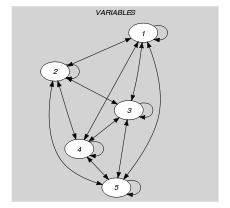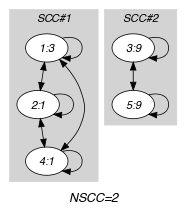5.277. ninterval
| DESCRIPTION | LINKS | GRAPH |
- Origin
- Constraint
- Arguments
- Restrictions
- Purpose
Consider the intervals of the form where is an integer. is the number of intervals for which at least one value is assigned to at least one variable of the collection .
- Example
-
In the example, the third argument defines the following family of intervals , where is an integer. Values 3, 1, 9, 1 and 9 are respectively located within intervals , , , and . Since we only use the two intervals and the first argument of the constraint is set to value 2.
- Typical
- Symmetries
Items of are permutable.
An occurrence of a value of that belongs to the -th interval, of size , can be replaced by any other value of the same interval.
- Arg. properties
Functional dependency: determined by and .
Contractible wrt. when and .
Contractible wrt. when .
- Usage
The constraint is useful for counting the number of actually used periods, no matter how many time each period is used. A period can for example stand for a hour or for a day.
- Algorithm
- See also
related: ( replaced by ), ( replaced by ), ( replaced by of ).
specialisation: ( replaced by ).
- Keywords
constraint arguments: pure functional dependency.
constraint type: counting constraint, value partitioning constraint.
final graph structure: strongly connected component, equivalence.
modelling: number of distinct equivalence classes, interval, functional dependency.
- Arc input(s)
- Arc generator
-
- Arc arity
- Arc constraint(s)
- Graph property(ies)
-
- Graph model
Parts (A) and (B) of Figure 5.277.1 respectively show the initial and final graph associated with the Example slot. Since we use the graph property we show the different strongly connected components of the final graph. Each strongly connected component corresponds to those values of an interval that are assigned to some variables of the collection. The values 1, 3 and the value 9, which respectively correspond to intervals and , are assigned to the variables of the collection.
Figure 5.277.1. Initial and final graph of the constraint


(a) (b)